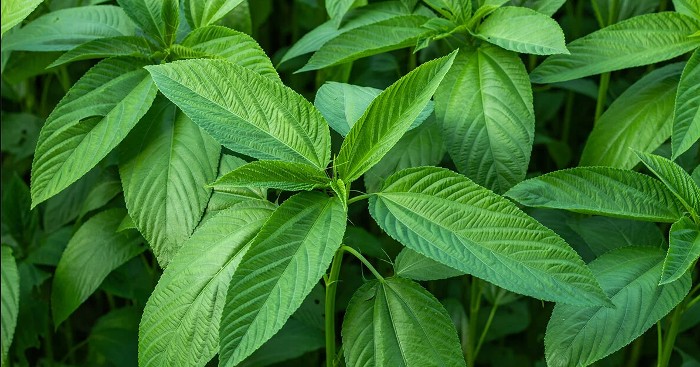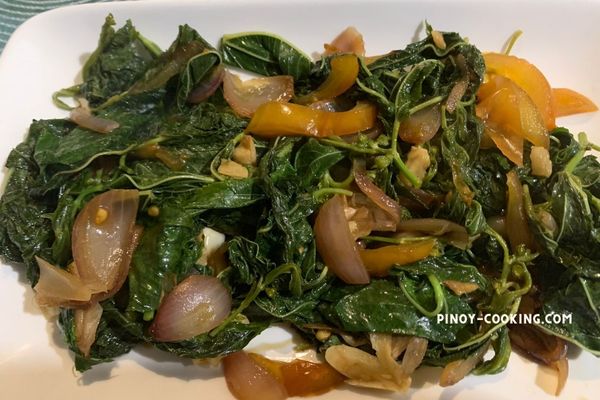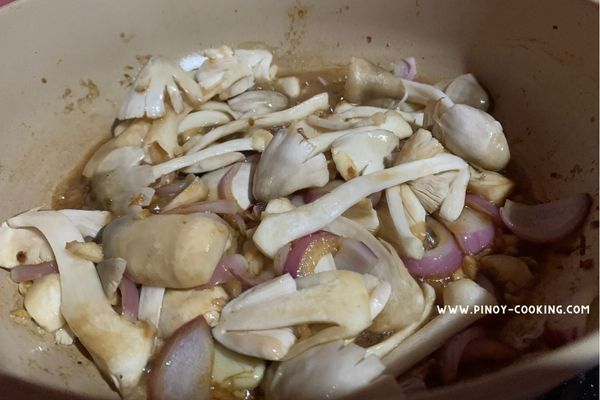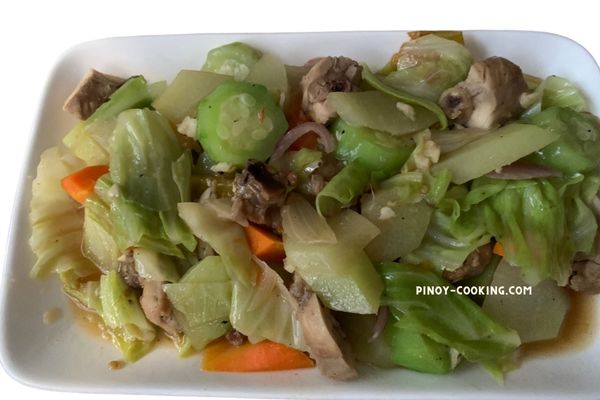Saluyot is a leafy green vegetable called jute or Jew’s mallow in English. It is grown and eaten in many places worldwide, including Southeast Asia, Africa, and the Middle East. The plant is a Corchorus with long, thin leaves and small yellow flowers. Corchorus is a genus category ofroughly 40-100 flowering plants in the Malvaceae family that are native to tropical and subtropical climates worldwide.
Saluyot is often used in Filipino stews, soups, and salads because of its slightly bitter flavor and slimy texture. It is also considered good for your health because it has a lot of fiber and nutrients.
Saluyot’s history and importance in Filipino cuisine
Saluyot has been used in Filipino cuisine for generations, with records dating back to pre-colonial times. The ancient Tagalogs and Kapampangans employed it as a medicinal herb because they felt it had therapeutic effects for various disorders.
Saluyot later became a common element in Filipino cuisines like sinigang, dinengdeng, and pinakbet, where it is frequently coupled with mixed vegetables and meats. Saluyot is renowned for its nutritional value, as well as its distinct flavor and texture. It is high in vitamins, minerals, and antioxidants. Saluyot is still a common element in Filipino cooking and is well appreciated for its excellent taste and health advantages.

Saluyot’s nutritional and health benefits
Nutritional value and benefits
Saluyot is high in nutrients and may have multiple health advantages. Saluyot has the following nutritional value and benefits:
- Rich in fiber: Saluyot is high in dietary fiber, which promotes healthy digestion and prevents constipation.
- Saluyot is high in vitamins and minerals, including vitamins A, C, and E, as well as calcium, iron, and potassium. These nutrients are necessary for bone, skin, and immune system health.
- Saluyot is high in antioxidants, which protect the body from free radical damage, which can lead to chronic diseases, including cancer and heart disease.
- Saluyot has been proven to have anti-inflammatory properties, which may aid in the prevention of chronic inflammation-related disorders such as arthritis, asthma, and cardiovascular disease.
- Saluyot is low in calories and high in fiber, which can help enhance feelings of fullness and lower overall calorie consumption, thereby assisting in weight loss.
- Blood sugar control: Because to its high fiber content, which delays glucose absorption in the bloodstream, saluyot may help to balance blood sugar levels.
Comparison to other vegetables and greens
Saluyot is a nutritious vegetable comparable to other leafy greens in terms of its nutritional value. Here are some comparisons to other popular vegetables and greens:
Spinach
Spinach is a leafy green vegetable with vitamins A and C, iron, and calcium. It is also a good source of antioxidants, like saluyot.
Kale
Kale is another leafy green high in fiber, vitamins A, C, and K, and minerals like iron and calcium. It is also a good source of antioxidants, like saluyot.
Broccoli
Broccoli is a cruciferous vegetable with fiber, vitamins C and K, and minerals like calcium and potassium. It is also a good source of antioxidants, like saluyot.
Sweet potato leaves
Sweet potato leaves are also a leafy green high in fiber, vitamins A and C, and minerals like calcium and iron. They are also a good source of antioxidants, like saluyot.
Role in traditional medicine and healing
Saluyot has been used in traditional medicine for its potential healing properties for centuries. Here are some ways saluyot has been used in traditional medicine:
- Digestive health: Saluyot has been used to promote digestive health, including alleviating constipation, diarrhea, and stomach pains. The high fiber content in saluyot may help to regulate bowel movements and improve overall digestive function.
- Respiratory health: Saluyot has been used to treat respiratory problems such as asthma, coughs, and colds. Its anti-inflammatory properties may help reduce inflammation in the respiratory tract, making breathing easier.
- Skin health: Saluyot has been used topically to treat skin conditions such as wounds, rashes, and sunburn. Its high vitamin C content may help to promote skin healing and reduce inflammation.
- Pregnancy and lactation: Saluyot has been used to support healthy pregnancy and lactation, as it is high in folate, a nutrient important for fetal development and lactation.
- Overall health and wellness: Saluyot has been used as a general health tonic, with potential benefits for overall health and wellness. Its high nutrient content, including vitamins and minerals, may help to support the body’s overall health and vitality.

Culinary Uses of Saluyot
Traditional Filipino dishes that feature saluyot
Saluyot is a popular ingredient in traditional Filipino cuisine, particularly in the country’s southern regions. Here are some classic Filipino dishes that feature saluyot:
- Sinigang na isda sa saluyot: This is a popular fish soup dish that features saluyot leaves in a tamarind-based broth. The saluyot leaves add a slight bitterness and earthy flavor to the soup.
- Adobong saluyot: In this dish, the saluyot leaves are cooked in a sauce made from vinegar, soy sauce, garlic, and black pepper. The dish is often served with rice and is a popular side dish.
- Ginataang saluyot: This dish contains saluyot leaves cooked in coconut milk with onion, garlic, and ginger. It can be served as a main or side dish with rice.
- Pinakbet: This is a popular vegetable dish in the Philippines that typically includes bitter melon, eggplant, tomato, and string beans, as well as saluyot leaves. The vegetables are stir-fried in garlic and onions and then simmered in a shrimp paste sauce.
- Laing: This dish from the Bicol region is made with taro leaves and coconut milk, with saluyot leaves added for extra nutrition and flavor. It’s typically served with rice and is often spicy.
Saluyot’s versatility in cooking and pairing with other ingredients
Saluyot is a versatile leafy green used in various dishes and pairs well with many different components. Here are some examples of how saluyot can be used in cooking and paired with other ingredients:
- Soups and stews: Saluyot leaves can be added to soups and stews for extra nutrition and flavor. They pair well with ingredients like fish, chicken, and pork and other vegetables like tomatoes and onions.
- Stir-fries: Saluyot leaves can be stir-fried with other vegetables, such as bell peppers, onions, and carrots, for a nutritious and flavorful side dish. They also pair well with tofu, chicken, and shrimp.
- Salads: Saluyot leaves can be used in salads to add extra nutrition and texture. They pair well with ingredients like tomatoes, cucumbers, and avocado and can be dressed with vinaigrettes or creamy dressings.
- Grilled dishes: Saluyot leaves can be used as a wrapping for grilled meats, seafood, or vegetables, adding flavor and nutrition. They can also be grilled independently and served as a side dish.
- Smoothies and juices: Saluyot leaves can be blended into smoothies or juices for a nutrient-dense drink. They pair well with fruits like bananas, pineapples, mangoes and other leafy greens like spinach and kale.
Saluyot’s mild flavor and texture make it a great addition to soups, stews, stir-fries, salads, grilled dishes, smoothies, and juices.
Popular cooking methods and techniques for saluyot
Saluyot can be cooked using various methods and techniques depending on the dish and the desired outcome. Here are some popular cooking methods and techniques for saluyot:
- Boiling: Saluyot leaves can be boiled in water for a few minutes until tender. This is a common method for preparing saluyot for soups and stews.
- Stir-frying: Saluyot leaves can be stir-fried with vegetables and meats for a quick and nutritious dish. This method preserves the texture and flavor of the leaves.
- Steaming: Saluyot leaves can be steamed for a few minutes until tender. This method retains the nutrients of the leaves while cooking them gently.
- Grilling: Saluyot leaves can be grilled on a barbecue or in a grill pan for a smoky and flavorful side dish or wrapped for grilled meats, seafood, or vegetables.
- Sauteing: Saluyot leaves can be sauteed in oil or butter with garlic and onions for added flavor. This method can be used to prepare side dishes or incorporate saluyot into other dishes like omelets or frittatas.
- Blending: Saluyot leaves can be blended with other ingredients like fruits, vegetables, and nuts to create smoothies, juices, and dips.
How to Grow and Harvest Saluyot
Climate and soil requirements for saluyot
Saluyot is a hardy and adaptable plant that can grow in a range of climates and soils. However, certain requirements should be considered to ensure optimal growth and yield. Here are some climate and soil requirements for saluyot:
- Climate: Saluyot grows best in warm and humid climates with temperatures ranging from 20-35°C. It can be grown in both tropical and subtropical regions. It requires at least 6 hours of sunlight per day.
- Soil: Saluyot prefers well-drained soils that are rich in organic matter. It can grow in various soils, including sandy, loamy, and clay soils. The optimal pH range for saluyot is 6.0 to 7.5.
- Water: Saluyot requires regular watering, especially during dry periods. It is important to avoid waterlogging as it can lead to root rot.
- Fertilizer: Saluyot benefits from regular fertilization with a balanced fertilizer that contains nitrogen, phosphorus, and potassium. Organic fertilizers like compost and manure can also enrich the soil.
- Pest and disease control: Saluyot is susceptible to a number of pests and diseases, including aphids, caterpillars, and leaf spot. It is important to monitor the plants regularly and use appropriate pest and disease control measures, such as crop rotation, use of biocontrol agents, and application of pesticides as necessary.
Harvesting and preparing saluyot leaves and stems
Saluyot can be easily propagated and grown in home gardens, small farms, and commercial plantations. Here are the steps for the cultivation and propagation of saluyot:
- Seed selection: Choose high-quality seeds from a reliable source. Saluyot seeds are small, dark brown, and oblong in shape.
- Soil preparation: Prepare the soil by removing weeds and debris, and tilling the soil to a depth of 15-20 cm. Add compost or manure to enrich the soil.
- Planting: Plant the seeds directly into the soil or start them indoors in seed trays before transplanting. Plant the seeds at 1-2 cm depth and space them 30-50 cm apart.
- Watering: Water the seeds and seedlings regularly, especially during dry periods. Avoid overwatering as it can lead to root rot.
- Fertilizer: Apply a balanced fertilizer or compost every 3-4 weeks to provide nutrients to the plants.
- Pest and disease control: Monitor the plants regularly for pests and diseases, and use appropriate control measures. Crop rotation, use of biocontrol agents, and application of pesticides can be used to control pests and diseases.
- Harvesting: Saluyot can be harvested 6-8 weeks after planting. Harvest the leaves when young and tender, and avoid harvesting the entire plant to allow for regrowth.
- Propagation: Saluyot can be propagated by stem cuttings. Take 10-15 cm cuttings from the top of the plant and remove the lower leaves. Plant the cuttings in well-drained soil and keep them moist until they establish roots.
Overall, saluyot is a relatively easy plant to propagate and cultivate. Selecting high-quality seeds, preparing the soil, regular watering and fertilization, pest and disease control, harvesting, and propagation are important steps in the cultivation of saluyot.
Conclusion
Recap of saluyot’s benefits and culinary uses and Call to action to try incorporating saluyot into your diet and cooking.



